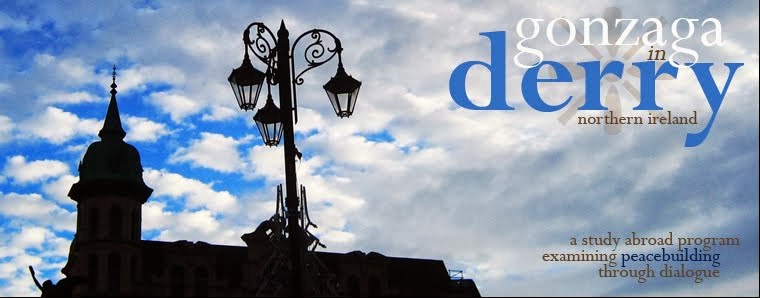By Katie Hutchens
The city of Derry, and all of Northern Ireland, has long been associated with "the troubles" or "the conflict", with the majority of the focus on the time between the late 1960's to late 1990's. In a land where the combatants have not always worn uniforms, it is interesting to note that this area was once a temporary home to uniformed soldiers on their way to a World War.
An American flag with 48 stars hangs in the St. Columb Cathedral just inside the city walls. It's explained to us by our tour guide that this is an authentic World War Two battle flag, now retired to hang until it disintegrates high above the pews. The ceiling is decorated with battle flags from every military group who worshipped at St, Columb's before their deployment.

 The statue of a 20th century sailor with a duffel bag over his shoulder stands near the banks of the Foyle River. The inscription below his feet reads, "In memory of those from all Nations who lost their lives in the Battle of the Atlantic. And in lasting tribute to the part played by the citizens of this city in the longest battle of the Second World War 1939-1945." Because Northern Ireland was part of the United Kingdom during the war, it operated as an Allied base for ships, troops and aircraft. This position also meant it was a target for German bombs and U-boats. While it may be difficult today to picture how it must have looked with 200 ships docked in the city, any student of human behavior can imagine ration-weary, local women falling for the charms of American, Canadian, and other foreign servicemen in possession of chocolate, chewing gym, cigarettes and nylons.
The statue of a 20th century sailor with a duffel bag over his shoulder stands near the banks of the Foyle River. The inscription below his feet reads, "In memory of those from all Nations who lost their lives in the Battle of the Atlantic. And in lasting tribute to the part played by the citizens of this city in the longest battle of the Second World War 1939-1945." Because Northern Ireland was part of the United Kingdom during the war, it operated as an Allied base for ships, troops and aircraft. This position also meant it was a target for German bombs and U-boats. While it may be difficult today to picture how it must have looked with 200 ships docked in the city, any student of human behavior can imagine ration-weary, local women falling for the charms of American, Canadian, and other foreign servicemen in possession of chocolate, chewing gym, cigarettes and nylons.
The flags and sailor monument made me want to learn more about Northern Ireland's role in the Second World War. How many first and second-generation Irish-Americans passed through this city on their way to battles on (or over) the continent? How did they feel to making the journey east again, after they (or their parents or grandparents) made such an effort to emigrate? How many families were politically divided by the decision of the South to remain neutral throughout the War?
As a final thought, it is important to mention that many attribute the lack of sectarian violence during the war years to the rare economic phenomenon of full employment. What does this say about the future? Would future conflicts on the island be better avoided if there was less unemployment and/or a focus on a shared fight against a common enemy? At least it is interesting to know there was a time, even though it was brief and rather extraordinary, that the focus on local division was temporarily overshadowed by larger geopolitical issues and economics.



No comments:
Post a Comment